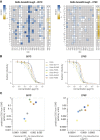A pseudovirus system enables deep mutational scanning of the full SARS-CoV-2 spike
- PMID: 36868218
- PMCID: PMC9922669
- DOI: 10.1016/j.cell.2023.02.001
A pseudovirus system enables deep mutational scanning of the full SARS-CoV-2 spike
Abstract
A major challenge in understanding SARS-CoV-2 evolution is interpreting the antigenic and functional effects of emerging mutations in the viral spike protein. Here, we describe a deep mutational scanning platform based on non-replicative pseudotyped lentiviruses that directly quantifies how large numbers of spike mutations impact antibody neutralization and pseudovirus infection. We apply this platform to produce libraries of the Omicron BA.1 and Delta spikes. These libraries each contain ∼7,000 distinct amino acid mutations in the context of up to ∼135,000 unique mutation combinations. We use these libraries to map escape mutations from neutralizing antibodies targeting the receptor-binding domain, N-terminal domain, and S2 subunit of spike. Overall, this work establishes a high-throughput and safe approach to measure how ∼105 combinations of mutations affect antibody neutralization and spike-mediated infection. Notably, the platform described here can be extended to the entry proteins of many other viruses.
Keywords: BA.1; Delta; Omicron; SARS-CoV-2; antibody escape; antibody neutralization; deep mutational scanning; pseudovirus; spike.
Copyright © 2023 The Author(s). Published by Elsevier Inc. All rights reserved.
Conflict of interest statement
Declaration of interests J.D.B. is on the scientific advisory board of Apriori Bio, Aerium Therapeutics, Invivyd, the Vaccine Company, and Oncorus and has recently consulted on topics related to viral evolution for Moderna and Merck. J.D.B., K.H.D.C., and C.E.R. receive royalty payments as inventors on Fred Hutch licensed patents related to viral deep mutational scanning. J.D.B., K.H.D.C., C.E.R., and B.D. are inventors on a pending patent application relating to the viral deep mutational scanning system described in this paper. R.B. is a consultant for IAVI, Adagio, Adimab, Mabloc, VosBio, Nonigenex, and Radiant. D.D.H. is a co-founder of TaiMed Biologics and RenBio, consultant to WuXi Biologics and Brii Biosciences, and board director for Vicarious Surgical. H.Y.C. consulted with Ellume, Pfizer, The Bill and Melinda Gates Foundation, GlaxoSmithKline, and Merck. H.Y.C. received research funding from Gates Ventures, Sanofi Pasteur, and support and reagents from Ellume and Cepheid outside of the submitted work.
Figures















Update of
-
A pseudovirus system enables deep mutational scanning of the full SARS-CoV-2 spike.bioRxiv [Preprint]. 2022 Oct 13:2022.10.13.512056. doi: 10.1101/2022.10.13.512056. bioRxiv. 2022. Update in: Cell. 2023 Mar 16;186(6):1263-1278.e20. doi: 10.1016/j.cell.2023.02.001. PMID: 36263061 Free PMC article. Updated. Preprint.
References
Publication types
MeSH terms
Substances
Grants and funding
LinkOut - more resources
Full Text Sources
Medical
Research Materials
Miscellaneous

